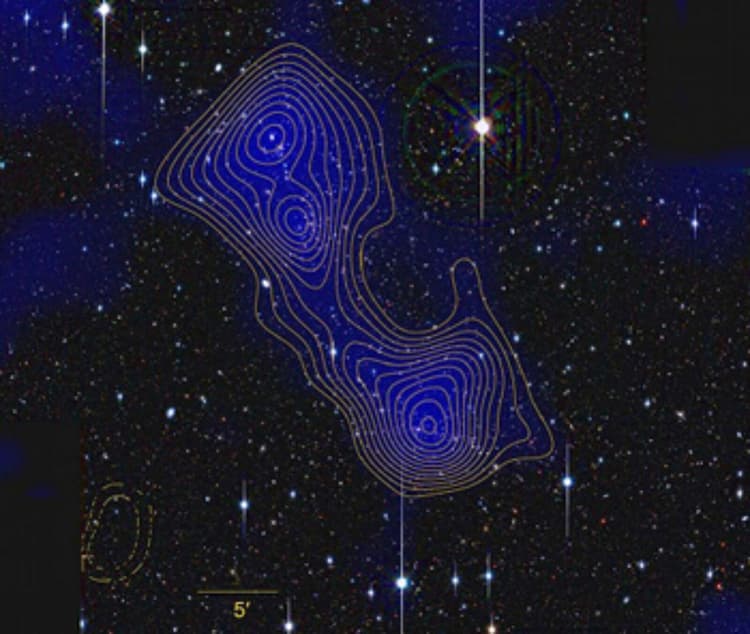Astronomers Detect Much Sought-After Cosmic Dark Matter Filament

(Originally published by Stanford University)
July 5, 2012
In the past 15 years, a remarkable consensus has emerged that the Universe is completely dominated by unseen dark matter and dark energy. Since they can't yet be observed directly, what we know about dark matter and dark energy comes from their effect on the ordinary matter which we can observe, or, additionally, from computer simulations of their behavior. Perhaps the most dramatic prediction from such simulations is that the dark matter, which comprises 80% of the matter in the Universe, ends up distributed throughout the cosmos in a structure resembling a vast spider web. Linear filaments of dark matter stretch across the enormous distances between galaxy clusters, and where the filaments intersect mass is concentrated and galaxy clusters form and grow from ordinary matter. The cosmic web structure arises due to the way that dark matter particles swarm together because of their gravitational attraction combined with the pull of the ever-expanding Universe.
Actually observing the structure of the cosmic dark matter web would be a stunning confirmation of our current understanding of dark matter and dark energy over the history of the Universe, and could open the door to much deeper understanding going forward. Any observation of the web has evaded astronomers, until now. In a recent paper in the journal Nature, a team including KIPAC postdoctoral researchers Norbert Werner and Aurora Simionescu and led by Jorg Dietrich of the University of Michigan, has presented evidence for the first detection of the presence of a cosmic web filament.

The filament in question stretches between two large galaxy clusters, known as Abell 222 and 223. The team's evidence for a filament is two-fold. On one hand, they were able to reconstruct the mass distribution of the two clusters and the region in between them using the technique of weak gravitational lensing. Weak lensing is where a concentration of mass subtly distorts the observed shapes of background objects because of the way matter bends light. It is one of the primary techniques that surveys such as Dark Energy Survey and the future Large Synoptic Survey Telescope will use to constrain dark energy by mapping the growth of massive structures through the history of the Universe. In the case of the current measurement, weak lensing observations revealed that the mass distribution included an overdense filament between the two clusters.
In addition, the team used X-ray observations with the XMM-Newton satellite previously reported by Werner and colleagues, which indicated enhanced X-ray emission from along the filament. This would be due to an overdensity of hot, ionized ordinary matter pulled in by gravity toward the massive filament. From the X-ray data, they estimate that the mass of this collection of hot ordinary matter in the filament is about 6 trillion times the mass of the Sun. Even so, it is only a tiny fraction of the total mass of the filament, which they estimate from the weak lensing measurements to be ten or more times that, so that 90% or more of the filament mass is in the form of dark matter, consistent with predictions that the cosmic web filaments are entirely dominated by dark matter.
It was previously considered to be very difficult to see evidence for such a filament because the density is so low compared with structures such as galaxy clusters which can be seen dramatically with weak lensing and X-ray observations. However, the team took advantage of the fact that this filament is largely aligned with our line of sight and perpendicular to the plane of the sky, meaning that we are looking through a lot of it and enhancing its effect on bending the light of background galaxies and emitting X-rays from hot gas. This observation is confirmation that a filament of dark matter exists between two massive galaxy clusters. It is also evidence that the predicted cosmic web structure of dark matter is real, and opens the door to further observations which can be compared to simulation predictions to reveal more precise information about the history of dark matter and dark energy in the Universe.
This work is described in a paper to appear in Nature and available from astro-ph at arXiv:1207.0809. Research at KIPAC is supported by the Department of Energy, the Kavli Foundation, the National Aeronautics and Space Administration, the National Science Foundation and Stanford University, as well as private donors. We are grateful to each of these sponsors for their trust and support.